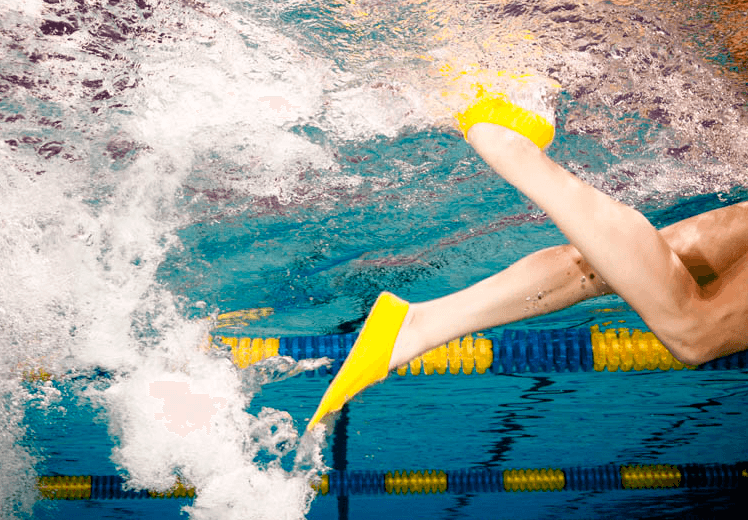Swimmers always get a little giddy when coach lets them use fins for the main set. Here are 5 things to keep in mind when using your fins.
The inherent joy that comes from wearing fins is apparent for anyone who has swum at even a novice level—the added surface area of the fins helps to supercharge our kicking and swimming speed in the water.
And if there is anything that swimmers of all abilities, from novices to Olympians, absolutely love it’s to go really, really fast during swim practice.
Here are 5 things to keep in mind when you are strapping yourself up to your swim fins:
1. Wait till you are almost in the water to put them on. Swimmers aren’t the most coordinated athletes in the bunch, and this becomes especially apparent when you watch one put on a pair of fins and try to walk across the pool deck. Besides being nearly impossible to walk in, the bottom of fins usually aren’t gripped. Wait till you get in the water or are sitting on the side of the pool to strap up. Much better to not let safety take a holiday than do an impersonation of Bambi on ice.
2. Length makes a difference. When coach lets us put on fins for the next set our first instinct is to always grab the biggest set we can find. We want those whale-fluke fins. But there is a drawback with the massive flippers: the larger and longer the fin, the slower your kicking tempo. This might not seem like a big deal, for swimmers who traffic in sprint events this is an unhelpful form of training. You can get the speed effects, and the strength building aspects of fins while also maintaining a kick tempo that is close to what it would be without fins. It just means selecting a pair of swim fins that aren’t suited for divers.
3. To sock, or not to sock. A really low tech way to go about making sure that you don’t get all blistered up is to put on an old pair of socks before sliding into your fins. View exhibit ‘A’ of what a rubber pair of fins can do to your feet with even a moderate amount of use in swim practice:
Blisters suck. (Another reason that you should make sure that you pick yourself up a pair of fins that are made of silicone, and not rubber.)
4. Use them at the appropriate time. Believe it or not, just because you are super stoked on getting to use your fins doesn’t mean that it’s appropriate. Most swim meet warm-ups don’t allow their use, for example. And even more than a few lap swims I have attended have discouraged their use. Which makes sense—when you have one swimmer torpedo’ing across the pool with fins on things can get a little unsafe, never mind the ocean-sized swells that you send cascading into the Aquafit class in the next lane.
5. Don’t let them become a crutch for a bad kick. Developing superior kick fitness takes a lot of time and energy spent on the kickboard. Building a really fast flutter kick or dolphin kick takes a mountain of hard work, I get it. So far those swimmers whose kick ain’t so hot, or who have the benefit of choosing to use fins or not, it can be tempting to use fins for much, if not all, of their kick work. Are you using fins for a specific purpose, or are you just avoiding doing regular kicking? Your fins are a tool to help you become a better kicker and swimmer, and shouldn’t be used as a crutch, or to duck that quality kick work.
See Also:
- Swim Fins: Everything You Ever Wanted to Know About Training with Flippers. In this comprehensive guide we break down the full list of benefits of training with fins, and feature a buyer’s guide featuring the best fins on the market.
- The Monofin: Your Weapon for a Killer Dolphin Kick. Want to level up your underwaters? Learn how a Monofin is one of the most potent weapons for taking your fly kick to the next level.
About YourSwimBook
 YourSwimBook is a log book and goal setting guide designed specifically for competitive swimmers. It includes a ten month log book, comprehensive goal setting section, monthly evaluations to be filled out with your coach, and more.
YourSwimBook is a log book and goal setting guide designed specifically for competitive swimmers. It includes a ten month log book, comprehensive goal setting section, monthly evaluations to be filled out with your coach, and more.
Learn 8 more reasons why this tool kicks butt.
Join the YourSwimBook weekly newsletter group and get motivational tips and more straight to your inbox. Sign up for free here.
